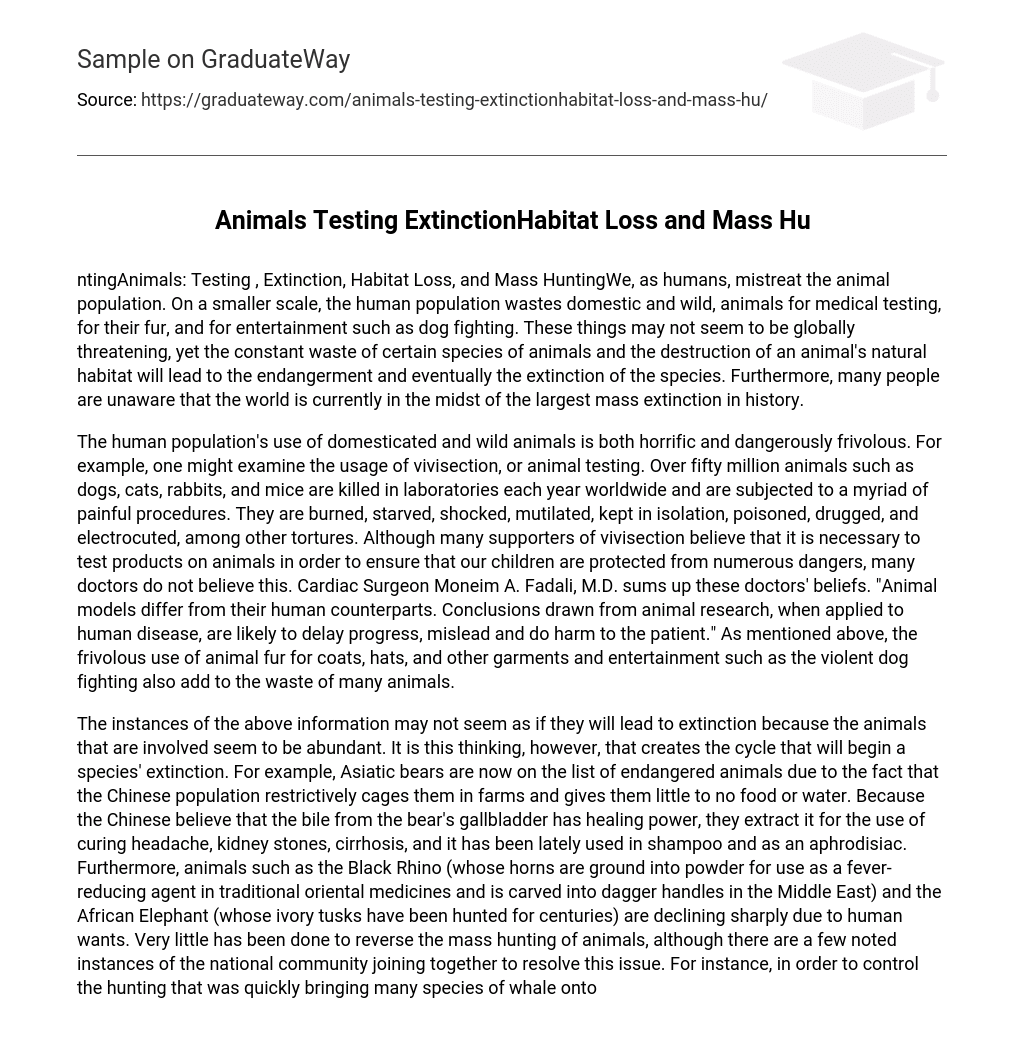ntingAnimals: Testing , Extinction, Habitat Loss, and Mass HuntingWe, as humans, mistreat the animal population. On a smaller scale, the human population wastes domestic and wild, animals for medical testing, for their fur, and for entertainment such as dog fighting. These things may not seem to be globally threatening, yet the constant waste of certain species of animals and the destruction of an animal’s natural habitat will lead to the endangerment and eventually the extinction of the species. Furthermore, many people are unaware that the world is currently in the midst of the largest mass extinction in history.
The human population’s use of domesticated and wild animals is both horrific and dangerously frivolous. For example, one might examine the usage of vivisection, or animal testing. Over fifty million animals such as dogs, cats, rabbits, and mice are killed in laboratories each year worldwide and are subjected to a myriad of painful procedures. They are burned, starved, shocked, mutilated, kept in isolation, poisoned, drugged, and electrocuted, among other tortures. Although many supporters of vivisection believe that it is necessary to test products on animals in order to ensure that our children are protected from numerous dangers, many doctors do not believe this. Cardiac Surgeon Moneim A. Fadali, M.D. sums up these doctors’ beliefs. “Animal models differ from their human counterparts. Conclusions drawn from animal research, when applied to human disease, are likely to delay progress, mislead and do harm to the patient.” As mentioned above, the frivolous use of animal fur for coats, hats, and other garments and entertainment such as the violent dog fighting also add to the waste of many animals.
The instances of the above information may not seem as if they will lead to extinction because the animals that are involved seem to be abundant. It is this thinking, however, that creates the cycle that will begin a species’ extinction. For example, Asiatic bears are now on the list of endangered animals due to the fact that the Chinese population restrictively cages them in farms and gives them little to no food or water. Because the Chinese believe that the bile from the bear’s gallbladder has healing power, they extract it for the use of curing headache, kidney stones, cirrhosis, and it has been lately used in shampoo and as an aphrodisiac. Furthermore, animals such as the Black Rhino (whose horns are ground into powder for use as a fever-reducing agent in traditional oriental medicines and is carved into dagger handles in the Middle East) and the African Elephant (whose ivory tusks have been hunted for centuries) are declining sharply due to human wants. Very little has been done to reverse the mass hunting of animals, although there are a few noted instances of the national community joining together to resolve this issue. For instance, in order to control the hunting that was quickly bringing many species of whale onto the list of endangered species, an international whaling convention was organized in 1946. From this, the International Whaling Commission was created and, through it, a scientific committee was set up in order to monitor the whale population and dub species “protected” if they have dwindling populations . Although this step was an initial start, further decreasing populations forced the IWC to prohibit, in 1982, commercial whaling indefinitely. Although the mass hunting of certain species is a large factor in extinction, one other, major threat to the animal population comes from the loss of a species’ natural habitat. The rainforest itself is home to over 50% of all species, yet we are losing 33.8 million acres of rainforest each year. Animals such as the Jaguar and the Colocolo are now endangered because of the loss of rainforest. Furthermore, rainforest destruction amounts to the extinction of four species per hour and one hundred species per day! These numbers are quite striking, yet they do not even include the percentage of animals that are endangered or extinct and do not reside in the rainforest. Animals such as the Giant Panda and the Island Grey Fox are examples of such species.
The extinction of numerous species has led to the sixth mass extinction in the world’s history. The first five extinctions occurred during a period of 650 million years to 65 million years ago and were all marked by some sort of natural disaster or climate change. This brings us to the aforementioned sixth extinction that we are currently experiencing. It is different in many ways from the other extinctions in that it is the most rapid, it is the largest (affecting from 17,000 to 100,000 species per year), and, most importantly, human hands are driving it. Humans are the sole source for this mass extinction, and whether it is due to the hunting and habitat loss that is explained above or the fact that the earth’s six billion human inhabitants are using almost 50% of the total energy available to sustain life on Earth (keeping in mind that with the exponential growth of the human population, this percentage will also rise), one thought must be brought to light. In the next thirty years, one fifth of all species will become extinct and in the next one hundred years, 50% of all species will be extinct. This is a staggering statistic and the horror of this is that one species, the human, is the cause of this mass extinction.
Unfortunately, the previous material is rendered completely ineffectual to many people due to the fact that there seems to be no surface global impact on humans. This is not true. The mistreatment of animals and the destruction of their habitats are global issues because the mass extinction of the earth’s species will eventually cause our own downfall. Each creature on Earth serves a specific purpose or function and, as these creatures are unable to perform these functions due to extinction, the lack of biodiversity will eventually reach and exterminate the entire human population.
Bibliography:





